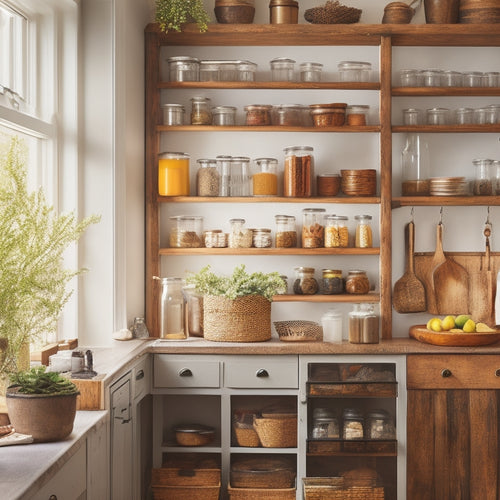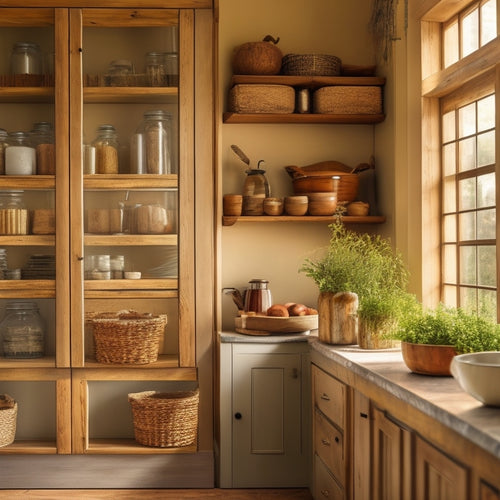
Root Cellars Revolutionize Alaska's Food Security
Share
Root cellars are changing Alaska's food security landscape, providing rural and remote communities with a crucial means of accessing fresh produce year-round despite the harsh Arctic climate. By extending the availability of locally sourced produce, these subterranean structures help reduce reliance on external supplies. Successful root cellars require deliberate design balancing temperature, humidity, and ventilation. Innovative designs in Alaska incorporate advanced temperature regulation techniques, maintaining high humidity levels and consistent temperatures between 32°F and 40°F. As these underground storages continue to play a critical role in enhancing food security, further exploration of best practices and cutting-edge designs can open up even greater potential.
Key Takeaways
• Root cellars in Alaska extend the availability of fresh produce during harsh winter months, reducing reliance on external supplies.
• Community-driven initiatives and DIY workshops promote knowledge sharing and collaboration for year-round access to locally sourced produce.
• Successful root cellars require deliberate design balancing temperature, humidity, and ventilation to preserve produce quality.
• Innovative designs in Alaska incorporate advanced temperature regulation techniques, insulation, and ventilation systems to maintain high humidity levels.
• Root cellars play a vital role in enhancing food security in Alaska's challenging climate, with real-life examples showcasing their feasibility and effectiveness.
Food Security in Alaska's Wilderness
How do Alaskan households, particularly those in rural and remote areas, maintain a steady supply of fresh produce during the harsh winter months when transportation routes are often impassable and grocery stores are few and far between? This question is critical to food security in Alaska's wilderness.
The answer lies in innovative solutions that prioritize wilderness preservation and community engagement. By adopting sustainable practices, such as root cellars, households can extend the availability of fresh produce, reducing reliance on external supplies.
Community-driven initiatives, like DIY workshops and online forums, promote knowledge sharing and collaboration, ensuring that Alaskans have access to fresh, locally sourced produce year-round.
Building Root Cellars for Success
What distinguishes a successful root cellar from a makeshift storage space is a deliberate design that balances temperature, humidity, and ventilation to preserve the freshness and quality of stored produce.
Innovative root cellar designs in Alaska incorporate advanced temperature regulation techniques, ensuring a consistent temperature between 32°F and 40°F.
High humidity levels are maintained through the use of insulation, ventilation systems, and carefully selected building materials.
To achieve success, it is essential to contemplate factors such as natural airflow, moisture control, and thermal mass when designing and building a root cellar.
Real-Life Root Cellar Examples
In Interior Alaska, innovative homesteaders like Tom and Kalin Seaton have successfully integrated root cellars into their households, showcasing the potential of these underground storage spaces to revolutionize food security in the region.
Located in Goldstream Valley, the Seatons' cellar is an exemplary model, constructed as an extension of their house's foundation. This root cellar is utilized for storing homemade canned goods, preserving root vegetables, and overwintering perennials and biennial plants.
Another notable example is the Miller family's cellar in Goldstream Valley, which features innovative designs, including the use of screw jacks to separate the cellar walls from the house foundation. These real-life examples demonstrate the feasibility and effectiveness of root cellars in enhancing food security in Alaska's challenging climate.
Overcoming Construction Challenges
Constructing root cellars in Interior Alaska's permafrost terrain and extreme climate poses unique construction challenges that require innovative solutions to guarantee peak effectiveness and longevity.
To overcome these challenges, builders must employ cold climate adaptations, such as specialized insulation and heating systems, to maintain ideal temperatures and humidity levels.
Innovative solutions, such as using screw jacks to separate cellar walls from house foundations, can also mitigate the risk of frost heave and structural damage.
Additionally, careful planning and design are essential to ensure proper ventilation, temperature regulation, and drainage.
Resources for Root Cellar Enthusiasts
Alaska's root cellar enthusiasts can access a wealth of knowledge and expertise through various workshops, online resources, and community engagement opportunities that provide valuable guidance on designing, building, and maintaining high-performance root cellars.
DIY workshops offered by Calypso Farm & Ecology Center, The Folk School, and Cooperative Extension Service provide hands-on experience and expert advice.
Online resources, such as the Cooperative Extension's free PDF on vegetable storage in root cellars, offer valuable information on best practices.
Community engagement opportunities, like Edible Alaska's Instagram community and local Edible Communities, facilitate networking and knowledge sharing among enthusiasts.
These resources empower individuals to overcome construction challenges and optimize their root cellar's performance, ultimately enhancing Alaska's food security.
Frequently Asked Questions
How Often Should Root Cellars Be Cleaned and Disinfected?
To maintain a safe and healthy root cellar environment, establish a regular cleaning schedule, ideally every 2-3 months, and disinfect surfaces with a 10% bleach solution; organize storage to prevent moisture accumulation and guarantee adequate air circulation.
Can Root Cellars Be Used for Storing Meat and Dairy Products?
While primarily designed for vegetable storage, root cellars can be adapted for meat preservation and dairy storage, provided proper temperature, humidity, and ventilation controls are implemented to guarantee safe and sanitary conditions for these sensitive products.
What Are the Ideal Humidity Levels for Different Types of Produce?
For best preserving of fruits and vegetables, ideal humidity levels vary: 80-90% for leafy greens, 70-80% for root vegetables, and 60-70% for fruits, ensuring prevention of mold and spoilage while maintaining freshness and quality.
Are There Any Specific Building Codes for Root Cellars in Alaska?
In Alaska, specific building codes for root cellars do not exist; however, construction guidelines and regulations are outlined in the International Residential Code (IRC) and the Uniform Building Code (UBC), ensuring safe and compliant root cellar construction.
Can Root Cellars Be Built in Areas With Permafrost?
In areas with permafrost, root cellars can be built using specialized construction techniques, such as insulated foundations and frost-protected shallow foundations, to mitigate permafrost challenges and guarantee safe, stable, and efficient food storage.
Related Posts
-

Tiered Kitchen Rack Ideas for Small Spaces
Tiered kitchen racks are perfect for maximizing small spaces while adding style and functionality. Install wall-mount...
-

Creative Organization Ideas for Tight Kitchen Spaces
To create an organized kitchen in tight spaces, think upwards. Install shelves that reach the ceiling and use wall-mo...
-

Freestanding Pantry Units for Farmhouse Kitchen Style
Freestanding pantry units perfectly blend beauty and function in your farmhouse kitchen. They maximize storage while ...


